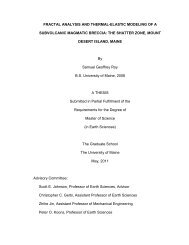design and characteristics of a split hopkinson pressure bar apparatus
design and characteristics of a split hopkinson pressure bar apparatus
design and characteristics of a split hopkinson pressure bar apparatus
Create successful ePaper yourself
Turn your PDF publications into a flip-book with our unique Google optimized e-Paper software.
elationships with many details omitted to<br />
keep our model simple. The following are<br />
the steps that lead to final <strong>design</strong>.<br />
Equations <strong>of</strong> Motion for Striker Bar<br />
Fig1. Simple FBD<br />
Where the individual terms are:<br />
vx - velocity <strong>of</strong> the projectile,<br />
P - initial <strong>pressure</strong> <strong>of</strong> compressed air tank,<br />
A - area <strong>of</strong> the projectile,<br />
L - travel distance (<strong>bar</strong>rel length)<br />
m - mass <strong>of</strong> the projectile<br />
x - displacement <strong>of</strong> the projectile.<br />
t - average travel time<br />
a - acceleration<br />
The values <strong>of</strong> A <strong>and</strong> m depend upon the<br />
radius <strong>and</strong> density ρ <strong>of</strong> the projectile itself.<br />
Force Balance in the x direction,neglecting<br />
kinetic <strong>and</strong> air friction gives the following:<br />
∑<br />
Fx = PA = max−<br />
direction<br />
From the realtionships above we obtained<br />
anticipated velocities <strong>and</strong> travel times for our<br />
5<br />
Projectile Travel Time, ms<br />
initial model. It is shown on the following<br />
graph.<br />
135<br />
125<br />
115<br />
105<br />
95<br />
85<br />
75<br />
65<br />
Split Hopkinson Bar Performance with varying Regulator Pressure<br />
24in long 3/4in diameter Barrel - 3.25in long 1/2lb projectile<br />
55<br />
35<br />
100 150 200 250 300 350 400 450 500 550 600<br />
Regulator Pressure, Psi<br />
Fig2.Shows velocity pr<strong>of</strong>ile (blue) <strong>and</strong> time <strong>of</strong> travel (pink).<br />
These were anticipated results <strong>and</strong> the sections<br />
below will show how much the final results<br />
differ from the optimal.<br />
FINAL DESIGN<br />
DESIGN OVERVIEW<br />
Projectile Travel Time Projectile Velocity<br />
The Split Hopkinson Bar Apparatus works<br />
with compressed gas. The compressed<br />
nitrogen tank has an initial <strong>pressure</strong> <strong>of</strong> 2200<br />
psig. There is a high <strong>pressure</strong> regulator that<br />
shows the current <strong>pressure</strong> in the tank <strong>and</strong> also<br />
limits the delivery <strong>pressure</strong> to the solenoid<br />
valve. The <strong>pressure</strong> <strong>of</strong> the exiting nitrogen can<br />
be set in variety <strong>of</strong> increments up to a<br />
maximum <strong>of</strong> 750 psi, which is the safe<br />
working <strong>pressure</strong> <strong>of</strong> the solenoid valve. Our<br />
computerized control system opens the<br />
85<br />
80<br />
75<br />
70<br />
65<br />
60<br />
55<br />
50<br />
45<br />
40<br />
Projectile Velocity, ft/s
















